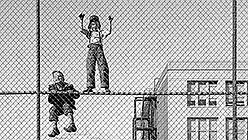Recently, a friend confided that he was on a quest to watch every episode of the 1970’s cop drama The Streets of San Francisco, which was released last year on DVD. It’s not that he’s a particular fan of Karl Malden or Michael Douglas, but he does love his city, which was the backdrop for the popular TV show.
As it turns out, “Streets” is actually a pretty good time capsule of San Francisco in the Watergate era, but if you want to see what San Francisco’s streets looked like a few decades before that, check out San Francisco Then, an exhibition of photographs taken during the 1940s and ’50s by Fred Lyon.
San Francisco Then, which runs through August 28, 2010, is a fitting first show for Modernbook Gallery’s new San Francisco location. Since 1999, the gallery has been quietly mounting lovely photography exhibitions in Palo Alto. Since 2005, Modernbook has also been publishing handsome, limited edition, hardbound books to accompany many of these shows, including a pair each by Fan Ho and Maggie Taylor. Fred Lyon gets a book for this show, too, and a new publication devoted to the surreal photography of Jerry Uelsmann is due later this year.
The Lyon exhibition is a mixture of movie-poster-size blowups interspersed by grids of smaller photos. There are lots of predictable shots of the Golden Gate Bridge and cable cars, many of them aerials, but the show is also heavy on neighborhood streets, some shrouded in fog, others attracting the photographer’s eye for their steep inclines and angles.
“Embarcadero Lunch” from 1948 is an example of the former. This large, grainy image features a man at its center walking through the haze toward Lyon’s camera. A sign promising “Lunch” and “Drinks” hangs above him and to the left, the faint ghost of the fogged-in Ferry Building looms behind.





